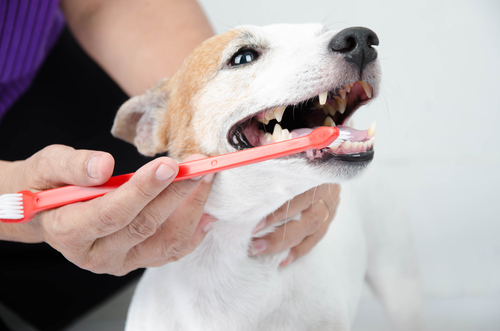
24 Apr Home Dental Care – A Guide to Brushing Your Pet’s Teeth
Just like humans, pets can also experience dental problems that can lead to pain, discomfort and even systemic issues like kidney or heart disease. Brushing your pet’s teeth is one of the things you can do to mitigate plaque and tartar buildup that contribute to other dental and overall health problems. We hope you find this step-by-step guide helpful in starting a dental care routine at home with your beloved pet(s).
Materials needed (most of these items can be found at your local pet store):
- Pet-friendly toothbrush (or a children’s toothbrush with soft bristles) or finger brush
- Pet friendly toothpaste (DO NOT USE HUMAN TOOTHPASTE! IT CAN CONTAIN FLUORIDE WHICH SHOULD NOT BE SWALLOWED, AND XYLITOL WHICH CAN BE TOXIC TO PETS)
- Treats or reward of some kind
Steps for Brushing Your Pet’s Teeth
- Choose the Right Time: Try to pick a time when your pet is calm and relaxed. While it is ideal to start when they are young, older pets can also be gradually introduced and accustomed to teeth brushing.
- Introduce the Toothpaste: Pet toothpaste is safe to be swallowed. Allow your pet to taste it first. You can apply a small amount of the paste to your finger and let them lick it off. Be sure to give lots of praise so they associate the toothpaste with a positive experience.
- Familiarize them with the Brush: Let your pet sniff and explore the toothbrush or finger brush without trying to brush their teeth initially. This helps them become accustomed to the brush. Then, let your pet lick some toothpaste off of the brush. Make sure and give lots of praise.
- Gently Start Brushing: Once your pet is comfortable with the toothbrush and toothpaste, you can start brushing. Lift your pet’s lips to expose their teeth and gums. Begin by gently brushing the outer surfaces of the front teeth in a circular motion. Focus on the outer surfaces of the teeth, at the edge of the gum tissue, as this is where a lot of tartar will build up. Once your pet is used to having the front teeth brushed, try to also brush the very back of the mouth to get to the molars and premolars. If your pet is reluctant, avoid getting forceful and just reach what you can without causing unnecessary stress.
- Take Your Time: Start with just a few teeth at a time, gradually increasing the number of teeth you brush as your pet becomes more comfortable. Be patient and go at a pace that is comfortable for your pet.
- Positive Reinforcement: Throughout the process, offer praise, petting, and treats as rewards for their cooperation. This really helps create a positive association with teeth brushing. Make it something they look forward to!
- Rinse and Repeat: Rinsing is not necessary when using canine toothpaste as they are designed to be safe if swallowed. You can wipe their mouth with a damp cloth if desired.
- Frequency: Aim to brush your pet’s teeth daily. Studies have shown that tooth brushing is most effective when done every 1-2 days. Daily brushing is ideal, but even a few times a week can significantly improve their oral hygiene. Some is better than none.
Regular Vet Checkups
You and I brush our teeth twice daily (usually), but we still have to go to the dentist for regular check-ups, right? The same goes for our four-legged friends. Your veterinarian can assess your pet’s oral health and recommend professional cleaning or other treatments if necessary. Daily brushing helps to improve your pet’s oral health, but does not replace doing anesthetized dental cleaning procedures. Pets will still generally need to have an anesthetized professional dental cleaning. For most pets, it is reasonable to have this done annually. However, some pets can go 2 years between cleanings, but pets with periodontal disease may need professional dental cleaning procedures at 6-month intervals.
Veterinary Dentist in Las Vegas
Remember that patience and consistency are paramount when it comes to brushing your pet’s teeth routinely. If your pet is particularly resistant, you can start by using your finger and gradually transition to a toothbrush. If your pet becomes aggressive, please remember that your safety comes first. We do not advocate this process if your safety is at risk. The goal is to make the experience positive and stress-free.



